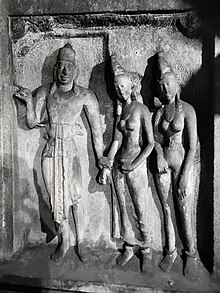Mahendravarman I
| Mahendravarman I | |
|---|---|
 Sculpture of Mahendravarman I with his queens at Adivaraha Cave Temple. | |
| Pallava Emperor | |
| Reign | 590–630 CE |
| Predecessor | Simhavishnu |
| Successor | Narasimhavarman I |
| Issue | Narasimhavarman I |
| House | Pallava |
| Father | Simhavishnu |
Aparajitavarman | 880–897 | |
|---|---|---|
Mahendravarman I (600–630 CE)
During his reign, the
Mahendravarma was succeeded to the throne by his more famous son Narasimhavarman I in 630 CE.[1] who defeated
Patronage of arts and architecture

Construction of these[
Fine examples of his rock-cut temples can be witnessed at
He was also the author of the play
Religion

Mahendrravarma was initially a patron of the
In literature and popular culture
Mahendravarman I is a prominent characters in
Notes
- ^ ISBN 1-57215-421-7.)
{{cite book}}: CS1 maint: location (link - ^ Seventeen, Volume (1885). Indian kingdoms by royal asiatic society of great britain. Royal asiatic society of great Britain.
- ^ Sastri 2008, p. 136
- ^ Bodhayan's Bhagwatajjukam edited by Veturi Prabhakara Sastri, Manmanjari Publications, Hyderabad, 2nd edition 1986, for more information Veturi Prabhakara Sastri Memorial Trust, 2-2-18/15/18/D/1, Bagh Amberpet, Hyderabad 500013
- ISBN 978-9-38060-734-4.
- ^ Gopal, Madan (1990). K.S. Gautam (ed.). India through the ages. Publication Division, Ministry of Information and Broadcasting, Government of India. p. 217.
- ^ Sastri 2008, p. 412
- ^ Sastri 2008, p. 413
- ^ Sastri 2008, p. 313
- PMID 28197009
- ^ a b C. 2004, pp. 5-6
- ^ Sastri 2008, p. 382–383
- ^ Stein, p. 122
References
- Prasad, Durga (1988). History of the Andhras up to 1565 A. D. Guntur, India: P. G. Publishers.
- C., Sivaramamurthi (2004). Mahabalipuram. New Delhi: The Archaeological Survey of India, Government of India. p. 3.
- Sastri, K A N (2008). A History of South India (4th ed.). New Delhi, India: Oxford University Press.
- Stein, Burton (1998). A history of India. Cambridge, MA: Blackwell Publishers. ISBN 0-631-20546-2.
